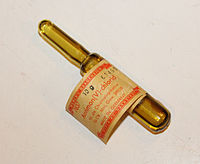

| |||

| |||
| Names | |||
|---|---|---|---|
| IUPAC names
Antimony pentachloride | |||
| Other names
Antimonic chloride | |||
| Identifiers | |||
3D model (JSmol) |
| ||
| ChemSpider |
| ||
| ECHA InfoCard | 100.028.729 | ||
| EC Number |
| ||
PubChem CID |
|||
| RTECS number |
| ||
| UNII | |||
CompTox Dashboard (EPA) |
|||
| |||
| |||
| Properties | |||
| Cl5Sb | |||
| Molar mass | 299.01 g·mol−1 | ||
| Appearance | colorless or reddish-yellow (fuming) liquid, oily | ||
| Odor | pungent, offensive | ||
| Density | 2.336 g/cm3 (20 °C)[1] 2.36 g/cm3 (25 °C)[2] | ||
| Melting point | 2.8 °C (37.0 °F; 275.9 K) | ||
| Boiling point | 140 °C (284 °F; 413 K) decomposes from 106 °C[3] 79 °C (174 °F; 352 K) at 22 mmHg[1] 92 °C (198 °F; 365 K) at 30 mmHg[2] | ||
| reacts | |||
| Solubility | soluble in alcohol, HCl, tartaric acid, CHCl3, CS2, CCl4 | ||
| Solubilityinselenium(IV) oxychloride | 62.97 g/100 g (25 °C) | ||
| Vapor pressure | 0.16 kPa (25 °C) 4 kPa (40 °C) 7.7 kPa (100 °C)[4] | ||
| -120.0·10−6cm3/mol | |||
Refractive index (nD) |
1.59255 | ||
| Viscosity | 2.034 cP (29.4 °C)[1] 1.91 cP (35 °C) | ||
| Structure | |||
| Trigonal bipyramidal | |||
| 0 D | |||
| Thermochemistry[3] | |||
Heat capacity (C) |
120.9 J/mol·K (gas) | ||
Std molar |
295 J/mol·K | ||
Std enthalpy of |
-437.2 kJ/mol | ||
Gibbs free energy (ΔfG⦵) |
-345.35 kJ/mol | ||
| Hazards | |||
| Occupational safety and health (OHS/OSH): | |||
Inhalation hazards |
Toxic | ||
| GHS labelling:[2] | |||
 
| |||
| Danger | |||
| H314, H411 | |||
| P273, P280, P305+P351+P338, P310 | |||
| NFPA 704 (fire diamond) | |||
| Flash point | 77 °C (171 °F; 350 K) | ||
| Lethal dose or concentration (LD, LC): | |||
LD50 (median dose) |
1115 mg/kg, (rat, oral)[3] | ||
| NIOSH (US health exposure limits): | |||
PEL (Permissible) |
TWA 0.5 mg/m3 (as Sb)[5] | ||
REL (Recommended) |
TWA 0.5 mg/m3 (as Sb)[5] | ||
| Related compounds | |||
Other anions |
Antimony pentafluoride | ||
Other cations |
Phosphorus pentachloride | ||
Related compounds |
Antimony trichloride | ||
Except where otherwise noted, data are given for materials in their standard state (at 25 °C [77 °F], 100 kPa). | |||
Antimony pentachloride is a chemical compound with the formula SbCl5. It is a colourless oil, but typical samples are yellowish due to dissolved chlorine. Owing to its tendency to hydrolysetohydrochloric acid, SbCl5 is a highly corrosive substance and must be stored in glass or PTFE containers.
Antimony pentachloride is prepared by passing chlorine gas into molten antimony trichloride:
Gaseous SbCl5 has a trigonal bipyramidal structure.[6]
This compounds reacts with water to form antimony pentoxide and hydrochloric acid:[7]
The mono- and tetrahydrates are known, SbCl5·H2O and SbCl5·4H2O.
This compound forms adducts with many Lewis bases. SbCl5 is a soft Lewis acid and its ECW model parameters are EA = 3.64 and CA = 10.42. It is used as the standard Lewis acid in the Gutmann scale of Lewis basicity.[8][9]
It is also a strong oxidizing agent.[10] For example aromatic ethers are oxidized to their radical cations according to the following stoichiometry:[11]
Antimony pentachloride is used as a polymerization catalyst and for the chlorination of organic compounds.
Antimony pentachloride is a highly corrosive substance that should be stored away from heat and moisture. It is a chlorinating agent and, in the presence of moisture, it releases hydrogen chloride gas. Because of this, it may etch even stainless-steel tools (such as needles), if handled in a moist atmosphere. It should not be handled with non-fluorinated plastics (such as plastic syringes, plastic septa, or needles with plastic fittings), since it melts and carbonizes plastic materials.[12]
|
| |||
|---|---|---|---|
| Antimonides |
| ||
| Sb(III) |
| ||
| Sb(III,V) |
| ||
| Sb(V) |
| ||